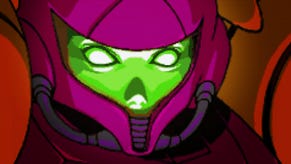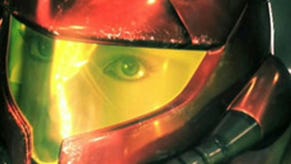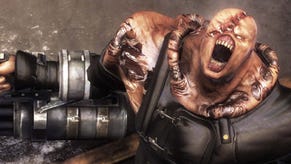Metroid Game By Game Reviews: Metroid Fusion
Metroid's fourth entry may have painted the saga into a corner, but those brushstrokes present a better picture than many want to admit.
This article first appeared on USgamer, a partner publication of VG247. Some content, such as this article, has been migrated to VG247 for posterity after USgamer's closure - but it has not been edited or further vetted by the VG247 team.
In military tactics, there exists a concept known as a fallback position: A tactical location to which an army can retreat if the tide of battle goes poorly. A fallback position allows one side to regroup and return to battle rather than abandon the fight altogether and accept defeat. When Nintendo returned to the Metroid franchise after nearly a decade of radio silence following Super Metroid, their fallback position took the form of Metroid Fusion.
Despite bearing the subtitle "Metroid IV," it's difficult not to see Fusion as a safe retreat in the event Metroid Prime didn't turn out as planned. Had fans rejected Prime, Nintendo could point to Fusion and say, "OK, you hate that one — but look, here's the proper Metroid sequel." The two games launched simultaneously in November 2002, each on a separate platform. Prime advanced the franchise's technological elements, daring to take Metroid into a three-dimensional, first-person perspective; Fusion, on the other hand, stuck with tried-and-true tech in an attempt to push the series' narrative forward. It might be the most unconventional franchise revival effort ever seen, giving fans two different games on the same day, each presenting its own vision of what "progress" meant in the context of Metroid.
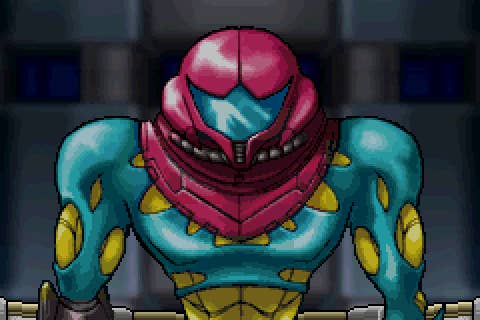
Prime may have been where Nintendo invested the lion's share of technical resources, but one gets the impression Fusion was the more important project to the company's own talent. Fusion saw the return of Metroid and Super Metroid designer Yoshio Sakamoto and the creative efforts of the Nintendo R&D1 internal division, whereas the Prime project belonged to Super Mario Bros. 2 USA designer Kensuke Tanabe and an external team at Retro Studios. If the Prime gambit hadn't paid off, Fusion would be there to make up for its failure.
Prime didn't turn out to be a disaster, of course — far from it. And the irony of the situation was that Prime's excellence ultimately overshadowed Fusion. Prime felt progressive, forward-thinking. Fusion felt to many players like a step backward. The fourth Metroid fell victim of Nintendo's new, hand-holding creative direction, carefully walking players through each and every step of the journey. That overly solicitous approach to design had begun in earnest with The Legend of Zelda: Ocarina of Time's Navi ("Hey! Listen!") and would reach its peak (or, perhaps, its nadir) with 2011's The Legend of Zelda: Skyward Sword. But you can certainly make a case that no single game suffered more from Nintendo's fear of allowing players to become lost (even for a moment) than Metroid Fusion, a core chapter in a series where the point had always been to get lost.

As such, Metroid Fusion rubbed many long-time fans the wrong way. With this entry, Metroid's creators set aside their long-running commitment to creating a sense of isolation and uncertainty through environmental design and game flow. In place of that solitary vibe, Samus Aran suddenly found herself on the receiving end of a seemingly endless stream of commands and objectives. As the direct successor to Super Metroid, a game that used its sound, visuals, world structure, and zero dialogue in concert to create a hostile alien world and depict a plot with genuine twists and emotional resonance, Fusion betrayed a fundamental Metroid tenet: Show, don't tell.
Without question, the single most controversial —even detested — element of Metroid Fusion comes in the form of its new character: Adam. In an enormous break from series tradition, Adam hovers over Samus like a brooding hen from start the finish. He issues orders, explains objectives, hints at hazards to come, and provides detailed maps of Samus's route. Adam's presence doesn't simply change the tenor of Fusion from what had come before, it completely reshapes the entire flow of the game.
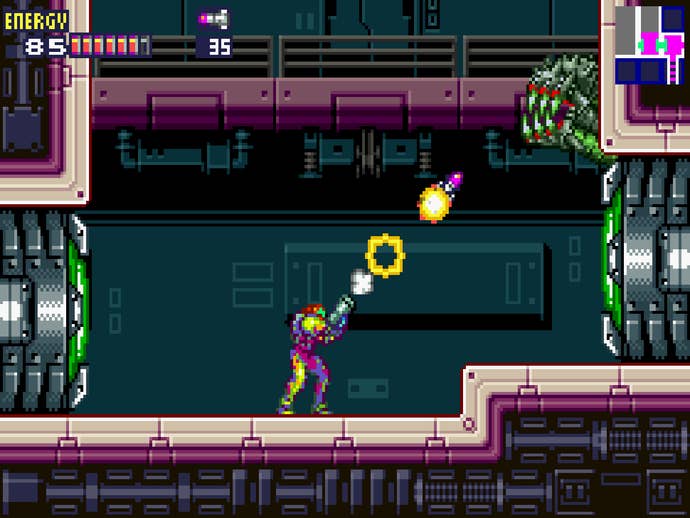
While Fusion's Game Boy Advance sprite work makes it look most like Super Metroid for Super NES, the game itself heavily references Metroid II. Understandably so: Both games debuted on portable systems. If Super Metroid was Metroid for NES perfected, you could see Fusion as an attempt to do the same for Metroid II. Even so, Nintendo didn't settle for revisiting the world of the second Metroid adventure and building on it, despite a bit of a head-fake in the intro. Instead, it leans into the artifice of Metroid II's design; in fact, it takes a literal approach to that artifice by presenting its recreation of Metroid II's world as a simulation.
But there's no getting past the fact that Adam's constant intrusions change the entire flow of the game. Fusion takes place entirely in a space station — Biologic Space Laboratories — and Samus's quest leads her throughout the six self-contained sectors of B.S.L. On its surface, this might not sound entirely different from Super Metroid's take on Zebes, a planet whose internal structure spans discrete regions. Fusion even presents its own take on the "glass tube" gag from Super Metroid, where late in the game you open an undocumented connection between the individual zones.
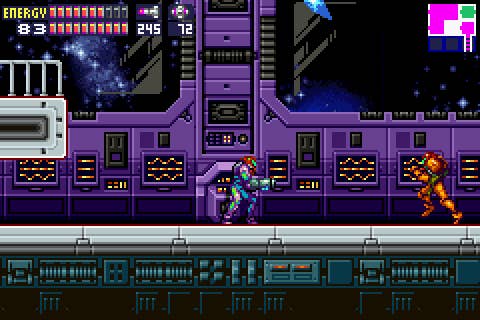
Where Fusion differs from Super Metroid is in its refusal to let you explore even a square meter of the station without being guided or chastised by Adam. The entrance to every sector of B.S.L. funnels you through what's called a "navigation room" — a computer station that locks you into or out of a sector as Adam dispenses commands and forces you to undertake a mission. These dialogue sequences invariably go to great lengths to explain to Samus her precise goals and the methods through which she must achieve them, along with a rundown of the hazards along the way. In doing so, the game developers (through Adam) drain the game of much of its sense of surprise and discovery.
If that were the beginning and end of Fusion's approach to progression, it would stand as an unmitigated disaster. It's not enough that Adam robs Metroid of the exploration at its heart; he does so in a didactic, tedious way.
But in fact, that's the whole point. You're meant to resent Adam, to chafe at his constant demands, to resent his constant and tiresome briefings. Adam makes the player feel powerless to control their actions because that's precisely Samus's condition throughout Fusion.
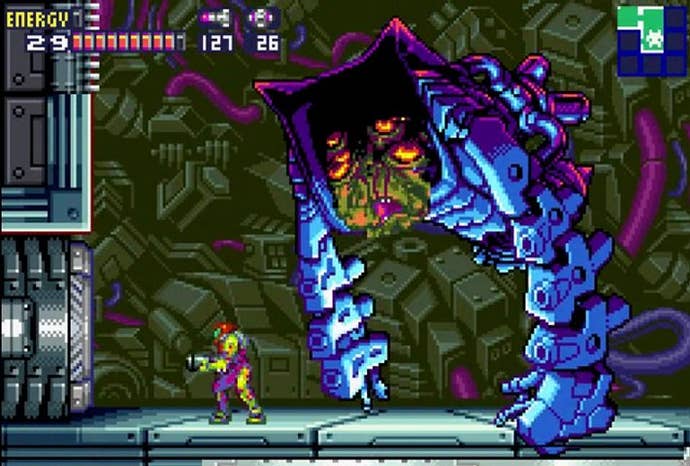
As Fusion begins, Samus returns to SR-388, the setting of Metroid II. The game doesn't take place there, though, because her actions during the course of Metroid II have had consequences: Her mission to wipe the metroid species from its native habitat has unbalanced SR-388's ecosystem and allowed an even greater threat to take root on the planet. A deadly organism known only as the X parasite, normally kept in check by metroids, has consumed life across the planet; Samus unwittingly becomes infected by it. The only thing that saves her life is a transfusion of metroid DNA.
This setup changes the stakes for Metroid Fusion, and with it a fundamental element of the series. From the very beginning, the Metroid saga presented Samus as an efficient, capable warrior: The top bounty hunter in the galaxy, the NES manual called her. While the games could occasionally pose a challenge in places, the power-up process that went hand-in-hand with progression in each adventure had the side effect of giving players the sensation of building Samus (and themselves) into an indestructible ball of death.
Fusion, however, begins by reducing Samus down to a weakling. Her power armor has largely been lost; most of it had to be surgically removed during her metroid DNA infusion, and the lightweight suit that remains is weak, and permanently bonded to her body. As a result, Samus begins the game with little firepower, and enemies hit harder than ever before. In previous Metroid entries, the monsters that roamed the environments generally posed a threat through attrition, slowly whittling down Samus's health. In Fusion, death can come quickly and unexpectedly — especially when bosses come into play. Samus slowly, agonizingly builds herself back up to her previous power levels, but Adam is quick to remind you how far below par you're fighting at every opportunity. Unlike most of Adam's nagging monologues, his warnings about Samus's disempowerment are both authentic and quite necessary.
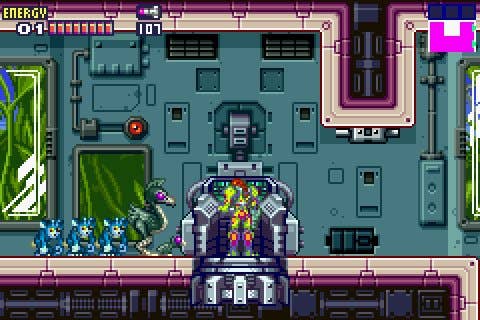
Fusion's designers put a lot of thought into the process of rebuilding Samus back to her old fighting form. While you more or less recover her powers in the usual order, the game offers a few surprises along the way: Abilities unaccounted for by Adam. It also allows the designers to reinvent the control interface to reflect the portable nature of Fusion and the limited number of face buttons on the GBA hardware versus the Super NES. The power-up system adopts a streamlined design, with players toggling attack modes by holding a shoulder button rather than cycling with the Select button. Weapon upgrades replace rather than complement one another: The missile becomes the super missile, which even gains a freeze component to replace the traditional ice beam... eventually.
Samus's new metroid-based biology definitely has benefits; when you inevitably encounter a new batch of metroids in a laboratory breeding program, the deadly creatures will happily ignore her, because she's one of "them." Yet it has a logical drawback as well: Samus can now be rendered inert by cold, just like actual metroids. In previous Metroid games, the only way to fight the eponymous creatures was to freeze them solid with Samus's ice beam, and here you find that tactic used against Samus herself. B.S.L.'s cold storage and ice-based research areas are completely inaccessible until you figure out a way to shield her from the low temperatures, and eventually the X parasites that have spread throughout B.S.L. learn to use her weakness to cold against her as well, having absorbed all of her combat knowledge by infecting her on SR-388.
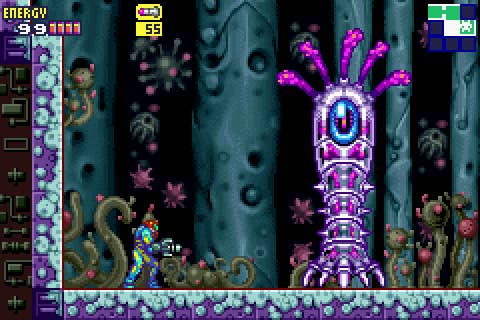
It's here that we come to the single most thrilling element of Metroid Fusion: Samus-X. See, the X parasite has the ability to assume the form and capabilities of any living creature it infects... and Samus begins her adventure by being afflicted. Eventually, the biological components of her contaminated suit take on a life of their own and begin stalking her throughout the station. Samus-X serves as a devastating contrast to our powerless heroine. The alien doppelgänger resembles Samus in peak condition from the end of Super Metroid (minus the temporary hyper beam): It possesses her full array of beam weapons, super missiles, power bombs, even the screw attack. And it constantly roams the station, hunting for the original version of itself which, by comparison, amounts to nothing more than a weak echo.
Samus-X may sound reminiscent of Resident Evil's Nemesis, and in fact Samus-X works much the same way here as the Nemesis did. The player will bump into the parasite at predetermined points in the station, and each encounter is heavily scripted and deliberately designed to force you to run for your life. You can stand and fight, but any such efforts invariably prove to be short-lived; Samus-X can destroy the real Samus in seconds flat. Instead, you have to escape through semi-scripted chase sequences. These require you to perform a variety of tasks, from hiding in a duct beneath the floor until the parasite passes through the room to surviving a volley of charged shots while clearing a path through a wall.

In many ways, Fusion's didactic text and intrusive story are as experimental as anything about Prime: A new direction for the series. Samus's skill reset symbolizes a sort of reboot for the franchise, and in any case her disempowerment proves to be merely a temporary situation. As she defeats the X parasite bosses throughout B.S.L., Samus absorbs and recovers her skills one by one. Once she finally defeats Samus-X, she returns to her old self — and the process of reaching that point, of at last being able to stand and fight this indestructible roving menace, gives your eventual triumph over Samus's clone the profound satisfaction that comes with a hard-earned victory. And even then, the game manages to throw in a few last-minute twists, including an omega metroid that no longer recognizes the fully restored Samus as one of its own species…
And there's one last important thing to note about Adam's constant intrusions: They become less and less frequent as the game goes on. Samus begins to take lengthier excursions on her own, repeatedly achieving tasks outside of Adam's proscribed mission log. Late in the game, you break outside the bounds of the station's environmental simulations and sneak around through the structure of the installation; despite being as carefully laid out as the rest of the game, slipping away from the computer's instructions and finding a different path forward creates a real thrill. Valve would recapture this same spirit a few years later with Portal, but Metroid Fusion did it first.
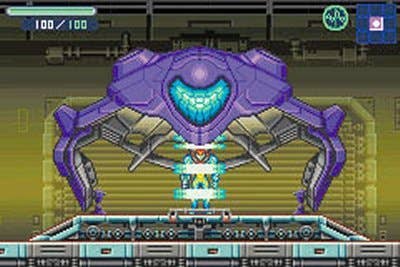
Unfortunately, we've never had the opportunity to see where Nintendo would take Samus's story next. Metroid Fusion is the final game in the series' timeline, at least so far. Every chapter of the series since then has muddled about in the past, falling into various points of the saga between the original Metroid and Fusion. Maybe the series' forward march was arrested by enormous popularity of Prime; or, perhaps, Sakamoto and crew simply don't know where to go with a Samus whose powers have been permanently restored, who has conclusively defeated the space pirates, the metroids, and the X parasites, and who has fallen out of favor with the Galactic Federation. At this point, the Metroid saga has literally been stalled out for half of its existence. And while Fusion may be better than many fans give it credit for, it doesn't make for a satisfying conclusion to Samus's story. Here's hoping that the dream of Metroid V — perhaps the never-announced Metroid Dread for DS — will surface someday soon.
ConclusionYour mileage may vary when it comes to this Super Metroid follow-up, but time has been kind to the game. Though it breaks from established Metroid design dogma, it does so in a meaningful way. The compromises Fusion inflicts on game mechanics underscore its narrative, and Samus's road to recovery simultaneously becomes a journey to reclaim the "proper" workings of a Metroid game. Although Yoshio Sakamoto would double down on Fusion's most frustrating elements for Other M, that doesn't damage Fusion's own integrity in the least. Uneven, but nevertheless excellent — and by far the single most challenging 2D Metroid game Nintendo has ever made.

